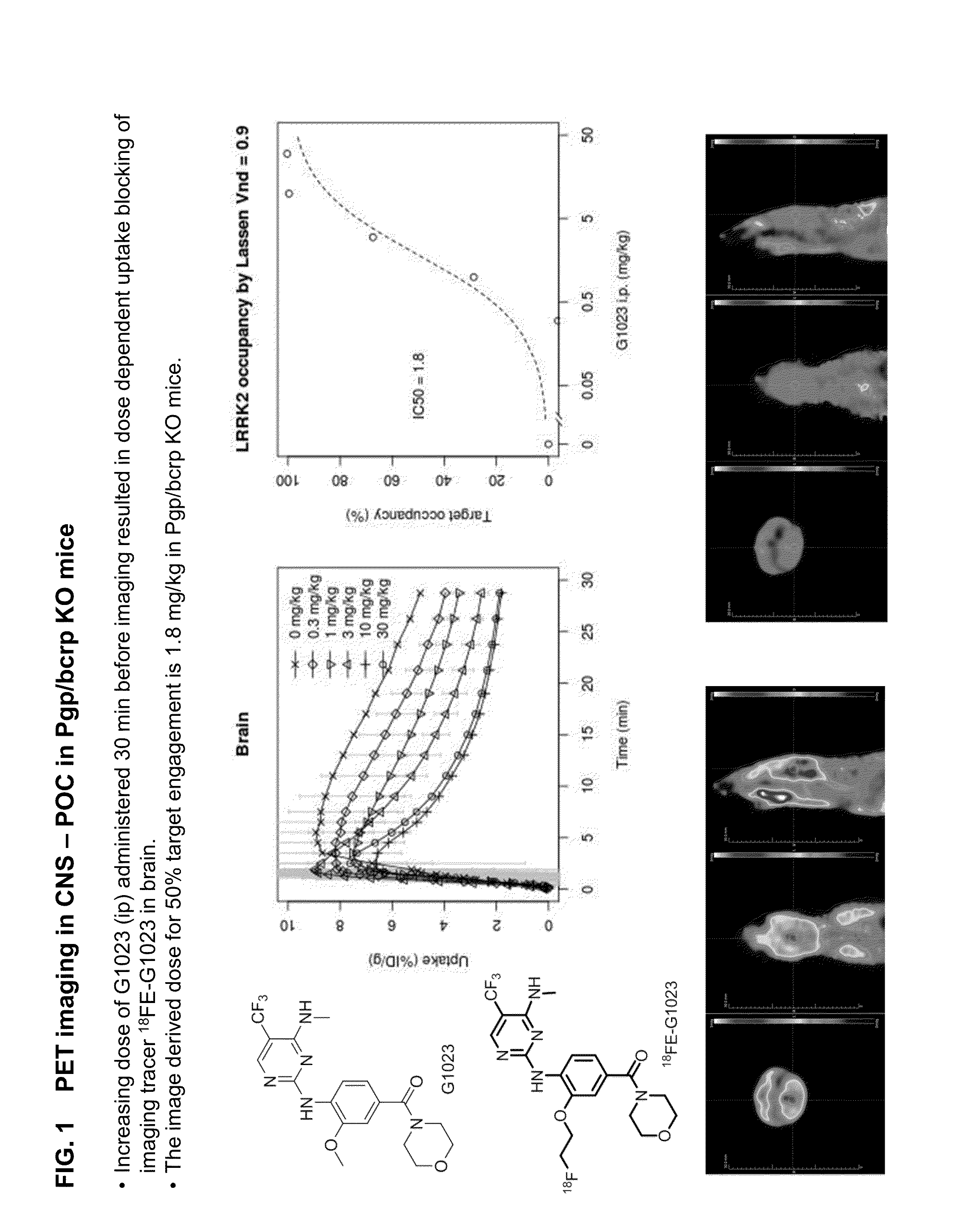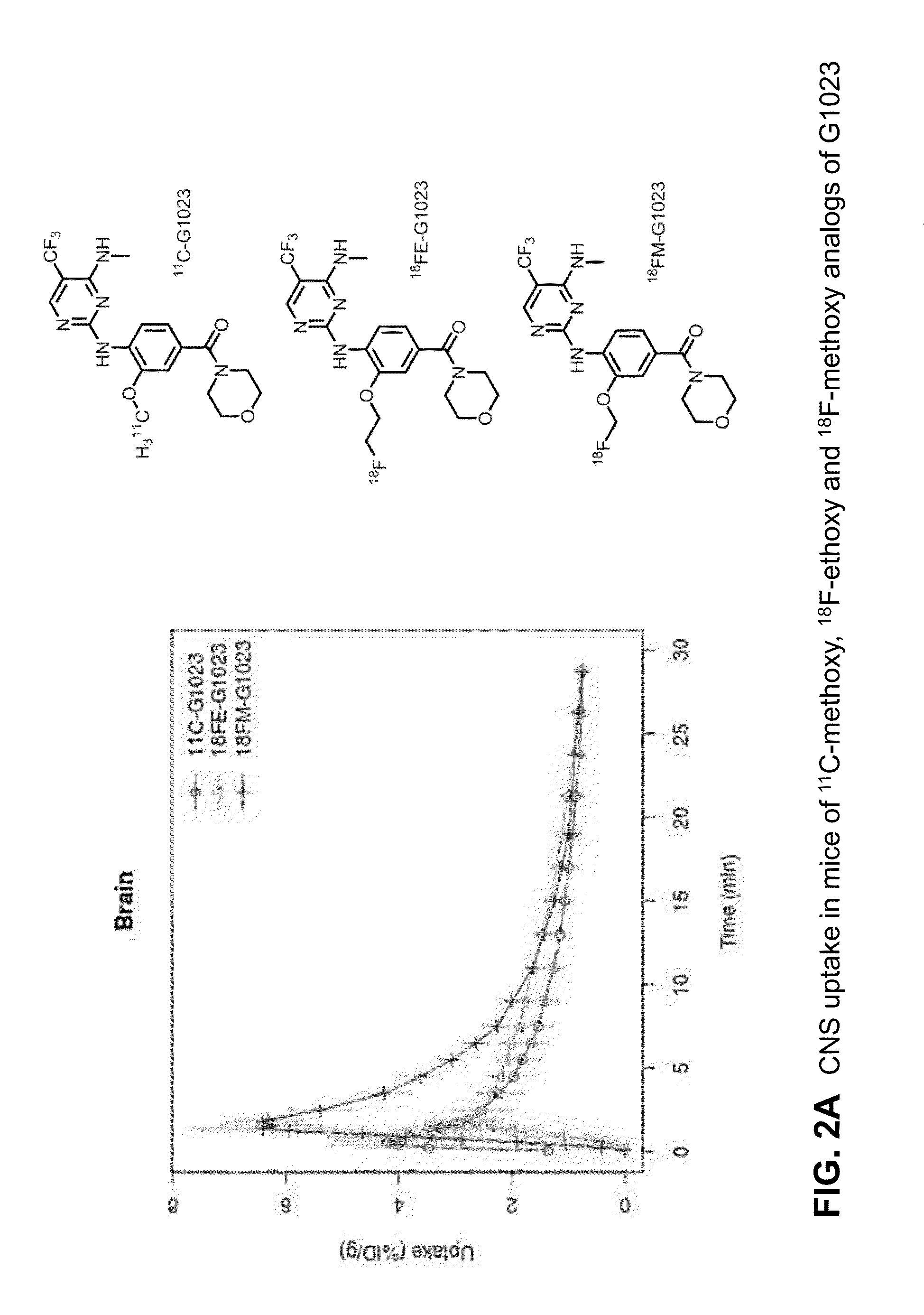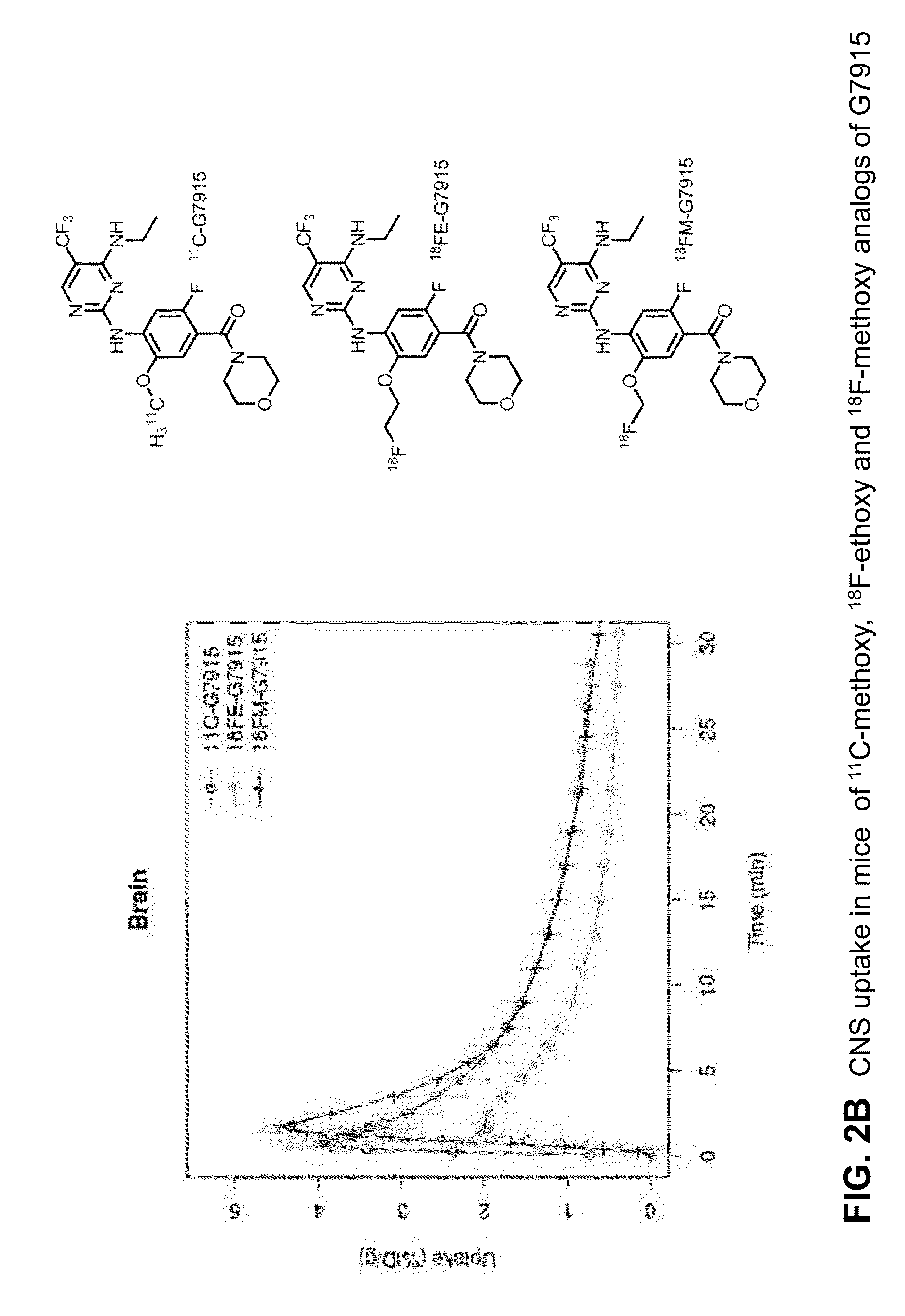Fluorine-18 and carbon-11 labeled radioligands for positron emission tomography (PET) imaging for lrrk2
a radioligand and fluorine-18 technology, applied in the field of compounds, can solve the problems of trembling, inability to direct and control the movement of the patient, and inability to move slowly,
- Summary
- Abstract
- Description
- Claims
- Application Information
AI Technical Summary
Benefits of technology
Problems solved by technology
Method used
Image
Examples
example 1
(3-(2-fluoroethoxy)-4-(4-(methylamino)-5-(trifluoromethyl)pyrimidin-2-ylamino)phenyl)(morpholino)methanone
[0951]
[0952]A mixture of 2-chloro-N-methyl-5-(trifluoromethyl)pyrimidin-4-amine (0.10 g, 0.47 mmol), (4-amino-3-(2-fluoroethoxy)phenyl)(morpholino)methanone (0.13 g, 0.47 mmol), trifluoroacetic acid (0.07 mL, 0.9 mmol) in 2-methoxyethanol (2.5 mL) was stirred at 95° C. for 6 hours. The reaction was the concentrated. The crude product was purified by reverse phase HPLC to give the title compound (61 mg, 29%).
[0953]Similarly prepared were:[0954][3-Methoxy-4-(4-methylamino-5-trifluoromethyl-pyrimidin-2-ylamino)-phenyl]-morpholin-4-yl-methanone; 1H NMR (400 MHz, DMSO) δ 8.31 (d, 1H), 8.19 (s, 1H), 8.07 (s, 1H), 7.21 (d, 1H), 7.07 (s, 1H), 7.02 (d, 1H), 3.90 (s, 3H), 3.56 (d, 9H), 2.92 (d, 3H); and[0955][4-(5-Chloro-4-methylamino-pyrimidin-2-ylamino)-3-hydroxy-phenyl]-morpholin-4-yl-methanone; 1H NMR (400 MHz, DMSO) δ 8.18 (d, J=8.3 Hz, 1H), 7.95 (s, 1H), 7.86 (s, 1H), 7.32 (d, J=4.6...
example 2
Radiolabeling
[0956]The radiolabeling of LRRK2 ligand consisted of two steps as follows (Scheme 1): Step 1. [18F]fluoride was incorporated to 18F-alkyl-R2 by nucleophilic substitution using R1-alkyl-R2 as a starting material (R1,2=p-toluenesulfonyl, methylsulfonyl, trifluormethylsulfonyl, halide; alkyl=methyl, ethyl, propyl. Step 2. The precursor (P) phenol is alkylated with 18F-alkyl-R2 (for example, 18F-alkyltosylate such as 18F-ethyl tosylate, 18F-methyl tosylate) to afford desired product. The crude product is purified by HPLC and formulated for injection. Preparation of such 18F-alkylating agents is well known and is described by Muschio et al., J. Labeled Compounds and Radiopharmaceuticals, 2005:48:735-747; Lu et al., J. Labeled Compounds and Radiopharmaceuticals, 2004:47:289-297; and others.
Preparation of [18F]fluoroethyl-G1023 ((3-(2-18Fluoroethoxy)-4-(4-(methylamino)-5-(trifluoromethyl)pyrimidin-2-ylamino)phenyl)(morpholino)methanone
Step 1: 2-18F-Ethylene glycol
[0957]18F-flu...
example 3
MicroPET Imaging
[0963]Mice were anesthetized with approx. 3% sevoflurane to effect and injected i.v. via the tail vein with 0.2-0.3 mCi of 18F-radiolabeled tracer in isotonic solution. The PET imaging was performed on an Inveon PET / CT scanner. Animals were placed head-first, prone position on the scanner bed and static or dynamic scans were acquired. Dynamic data were acquired for 0-120 min post tracer injection. Body temperature was measured by a rectal probe and maintained with warm air. Full-body iterative image reconstructions were obtained using maximum a posteriori algorithm (MAP, hyperparameter beta=0.05) and corrected for signal attenuation using the tissue density obtained from CT. Projections were created with IRW software (Siemens Preclinical Solutions) and used to obtain quantitative activity levels in each organ of interest using region-of-interest analysis.
Radiolabeled Compound Uptake and Imaging Results
[0964]Images of obtained with [18F]fluoroethyl-G1023 ((3-hydroxy-4...
PUM
 Login to View More
Login to View More Abstract
Description
Claims
Application Information
 Login to View More
Login to View More - R&D
- Intellectual Property
- Life Sciences
- Materials
- Tech Scout
- Unparalleled Data Quality
- Higher Quality Content
- 60% Fewer Hallucinations
Browse by: Latest US Patents, China's latest patents, Technical Efficacy Thesaurus, Application Domain, Technology Topic, Popular Technical Reports.
© 2025 PatSnap. All rights reserved.Legal|Privacy policy|Modern Slavery Act Transparency Statement|Sitemap|About US| Contact US: help@patsnap.com



